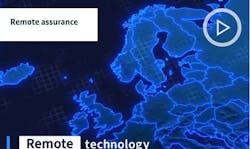ONLINE EXCLUSIVE: Will Covid-19 trigger a remote working revolution in the oil and gas industry?
Clinton Abbate, Lloyd’s Register
In every way imaginable, Covid-19 has turned the world on its head. In just six weeks every part of society, from governments and businesses to communities and families, have embraced digital remote working. Technology solutions that have been around for decades have been rapidly adopted.
Jump in the car or the train for the daily commute. Sign in at reception. Arrive at your desk. Quickly check emails, grab coffee and head straight to your weekly team meeting. Attend a few more internal meetings before lunch and then out to client meetings before the busy journey home.
A typical working day for many of us, just a couple of months ago. Since then, Covid-19 has fundamentally changed the way many of us are working, as lockdown measures were imposed around the world. It is amazing how quickly people adapted to working remotely and how new virtual communication and collaboration technologies were adopted.
A recent Gartner survey of HR managers revealed that more than 80% of their company’s employees are currently working remotely.
This poses a fundamental question: if decades of ingrained ways of working can be uprooted and transformed – almost overnight – why wasn’t the oil and gas industry quicker to make use of the myriad remote technologies available to help work more safely and efficiently prior to the pandemic?
Remote technologies and services
Many of the challenges we face now, and over the coming months are not new – we still feel the effects of the 2015/16 downturn. The urgent need to do more with less, while reducing costs, maintaining safety and integrity and driving productivity.
Since the coronavirus pandemic began, we have seen a rise in assurance and inspection services being delivered remotely and we expect to see this increase even further over the coming months. This uptick has included streaming high-quality data with smart cameras and mobile technology in real-time, drone assisted inspection services and augmented reality.
At the same time, we are seeing a spike in interest for support to develop optimization strategies. For example, with up to 75% fewer people working offshore on the UKCS just now, more and more companies are looking to remote maintenance optimization solutions to help them manage asset integrity.
For example, AkerBP uses advanced technology to minimize risk while optimizing asset integrity, maintenance and performance. By adopting this solution, it cut planned maintenance in half for its Skarv FPSO.
This approach also allowed a supermajor to reduce opex by $18 million and cut 74,000 hours of offshore labor in just 20 weeks.
Optimizing operations will also be crucial for wells which are already producing. With issues such as non-productive time accounting for 23% of well development spending (according to the UK Oil & Gas Authority) and integrity issues affecting 38% of oil and gas wells, it is critical that people, processes and products are managed effectively, and that investment is directed into the areas where it matters most, and where it can be most effective.
Technology adoption
Regardless of what technology makes possible, there will always be barriers to adoption – commercial, regulatory, safety and cultural, to name just a few.
One of the main regulatory challenges has always been that where on-site inspection or validation is required, remote and digital technologies cannot replace them, even if efficiency and – in some cases quality – is improved.
Coronavirus has seen some welcome change to these requirements, with regulators prepared to be flexible around the need for on-site visits and a physical presence at inspections. Will that flexibility outlast the virus? That remains to be seen, but the pace at which we adopt remote technologies is almost entirely dependent on what regulation will allow.
No one wanted a global pandemic, of course, however we have found ourselves with a testbed for increased trialing and testing of remote technologies. This is needed as much for regulators and auditors, to assess new methods of validation, as it is for operators and the supply chain who will become end-users of the technology.
Culture and mindset are other barriers we have experienced in the past, with the energy industry known for a go-slow approach to technology disruption. That eventually began to morph into a ‘fast-follower’ strategy for many companies.
We have seen our clients accelerate their internal QA and QC procedures to build in remote inspection service delivery methods. Where the early adopters of the technology did face opposition within their own organizations, they are now able to move quickly ahead, and this will undoubtedly cut capex costs from the supply chain in coming months and years.
Through our technology qualification service, we have provided a goal-based approach to help companies fast-track technology development from concept to deployment readiness. More recently, we have seen operators and start-ups alike spearhead the development of game-changing technology from corrosion sensors and 3D modelling, to robotics and wearables.
Post-Covid-19, keeping momentum and focus on digital and remote technologies will be critical, and the industry must not slip back into the way it has worked traditionally. Standard-setting organizations and EU directives will also need to address the opportunities to build remote solutions and similar capabilities into their standards as normal practice.
Like any new solution, technologies that enable remote service delivery will travel through typical development and adoption curves but at a significant pace thanks to digitalization. In the future, we can expect to see a new operating norm which will include unmanned oil and gas platforms with remote control centers, capex investments in digital over steel, and turnarounds which instead of being time-based, are determined by data and analytics.
Covid-19 has forced the world at large to change how it works – and people everywhere have risen to the challenge. Now is the time to apply this thinking and mindset to embrace remote technologies in oil and gas, which will transform how we work, for the better.
O5/28/2020
